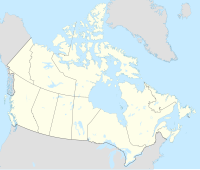world.wikisort.org - Canada
Halbrite (2016 population: 119) is a village in the Canadian province of Saskatchewan within the Rural Municipality of Cymri No. 36 and Census Division No. 2. The village is located approximately 20 kilometres south-east of the city of Weyburn on Highway 39 at the intersections of Highway 606 and 705.
Halbrite | |
|---|---|
Village | |
| Village of Halbrite | |
 Location of Halbrite in Saskatchewan  Halbrite (Canada) | |
| Coordinates: 49.488°N 103.558°W | |
| Country | |
| Province | |
| Region | Southeast |
| Census division | 2 |
| Rural Municipality | Cymri No. 36 |
| Government | |
| • Type | Municipal |
| • Governing body | Halbrite Village Council |
| • Mayor | Palmer Bruce |
| • Administrator | Aleshia Underwood |
| • MP | Robert Kitchen |
| • MLA | Dan D'Autremont |
| Area | |
| • Total | 1.20 km2 (0.46 sq mi) |
| Population (2016) | |
| • Total | 119 |
| • Density | 99.3/km2 (257/sq mi) |
| Time zone | UTC-6 (CST) |
| Postal code | S0C 1H0 |
| Area code | 306 |
| Highways | |
| Railways | Canadian Pacific Railway |
| [1][2][3][4] | |
Halbrite gets its name from three engineers who, at the time, worked with the Canadian Pacific Railway. Each contributed parts of their last names to make up the community's name: Hall, Bruce, and White.[5]
During the Second World War the Royal Canadian Air Force constructed a Relief Landing Field for RCAF Station Weyburn approximately 2 miles south of the village.[6]
History
Halbrite incorporated as a village on February 26, 1904.[7]
Demographics
In the 2021 Census of Population conducted by Statistics Canada, Halbrite had a population of 110 living in 49 of its 60 total private dwellings, a change of -7.6% from its 2016 population of 119. With a land area of 1.1 km2 (0.42 sq mi), it had a population density of 100.0/km2 (259.0/sq mi) in 2021.[10]
In the 2016 Census of Population, the Village of Halbrite recorded a population of 119 living in 51 of its 55 total private dwellings, a 9.2% change from its 2011 population of 108. With a land area of 1.2 km2 (0.46 sq mi), it had a population density of 99.2/km2 (256.8/sq mi) in 2016.[11]
See also
- List of communities in Saskatchewan
- Villages of Saskatchewan
- List of geographic acronyms and initialisms
References
- National Archives, Archivia Net, Post Offices and Postmasters
- Government of Saskatchewan, MRD Home, Municipal Directory System, archived from the original on November 21, 2008
- Canadian Textiles Institute. (2005), CTI Determine your provincial constituency, archived from the original on September 11, 2007
- Commissioner of Canada Elections, Chief Electoral Officer of Canada (2005), Elections Canada On-line, archived from the original on April 21, 2007
- Barry, Bill (September 2005). Geographic Names of Saskatchewan. Regina, Saskatchewan: People Places Publishing, Ltd. p. 177. ISBN 1-897010-19-2.
- Staff writer (c. 1942). Pilots Handbook of Aerodromes and Seaplane Bases Vol. 2. Royal Canadian Air Force. p. 43.
- "Urban Municipality Incorporations". Saskatchewan Ministry of Government Relations. Archived from the original on October 15, 2014. Retrieved June 1, 2020.
- "Saskatchewan Census Population" (PDF). Saskatchewan Bureau of Statistics. Archived from the original (PDF) on September 24, 2015. Retrieved May 31, 2020.
- "Saskatchewan Census Population". Saskatchewan Bureau of Statistics. Retrieved May 31, 2020.
- "Population and dwelling counts: Canada, provinces and territories, census divisions and census subdivisions (municipalities), Saskatchewan". Statistics Canada. February 9, 2022. Retrieved April 1, 2022.
- "Population and dwelling counts, for Canada, provinces and territories, and census subdivisions (municipalities), 2016 and 2011 censuses – 100% data (Saskatchewan)". Statistics Canada. February 8, 2017. Retrieved May 30, 2020.
Другой контент может иметь иную лицензию. Перед использованием материалов сайта WikiSort.org внимательно изучите правила лицензирования конкретных элементов наполнения сайта.
WikiSort.org - проект по пересортировке и дополнению контента Википедии
